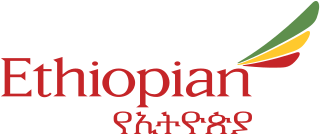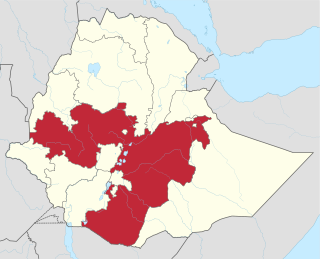
Mengistu Haile Mariam is an Ethiopian former politician and former military officer who was the head of state of Ethiopia from 1977 to 1991 and General Secretary of the Workers' Party of Ethiopia from 1984 to 1991. He was the chairman of the Derg, the Marxist-Leninist military junta that governed Ethiopia, from 1977 to 1987, and the president of the People's Democratic Republic of Ethiopia (PDRE) from 1987 to 1991.

Ethiopian Airlines Flight 961 was a scheduled international flight serving the route Addis Ababa–Nairobi–Brazzaville–Lagos–Abidjan. On 23 November 1996, the aircraft serving the flight, a Boeing 767-200ER, was hijacked en route from Addis Ababa to Nairobi by three Ethiopians seeking asylum in Australia. The plane crash-landed in the Indian Ocean near Grande Comore, Comoros Islands, due to fuel exhaustion; 125 of the 175 passengers and crew on board, including the three hijackers, died. This is the first recorded instance of a ditching utilizing a wide-body aircraft.

Ethiopian Airlines, formerly Ethiopian Air Lines (EAL), is the flag carrier of Ethiopia, and is wholly owned by the country's government. EAL was founded on 21 December 1945 and commenced operations on 8 April 1946, expanding to international flights in 1951. The firm became a share company in 1965 and changed its name from Ethiopian Air Lines to Ethiopian Airlines.

Addis Ababa University (AAU) is a national university located in Addis Ababa, Ethiopia. It is the oldest university in Ethiopia. AAU has thirteen campuses. Twelve of these are situated in Addis Ababa, and one is located in Bishoftu, about 45 kilometres (28 mi) away. AAU has several associated research institutions including the Institute of Ethiopian Studies. The Ministry of Education admits qualified students to AAU based on their score on the Ethiopian University Entrance Examination (EUEE).

Oromia is a regional state in Ethiopia and the homeland of the Oromo people. Under Article 49 of Ethiopian Constitution, the capital of Oromia is Addis Ababa, also called Finfinne. The provision of the article maintains special interest of Oromia by utilizing social services and natural resources of Addis Ababa.

Harar, known historically by the indigenous as Harar-Gey or simply Gey, is a walled city in eastern Ethiopia. It is also known in Arabic as the City of Saints.

Addis Ababa Bole International Airport is an international airport in Addis Ababa, Ethiopia. It is in the Bole district, 6 km (3.7 mi) southeast of the city centre and 65 km (40 mi) north of Bishoftu. The airport was formerly known as Haile Selassie I International Airport. It is the main hub of Ethiopian Airlines, the national airline that serves destinations in Ethiopia and throughout the African continent, as well as connections to Asia, Europe, North America and South America. The airport is also the base of the Ethiopian Aviation Academy. As of June 2018, nearly 380 flights per day were using the airport.
The Siltʼe people are an ethnic group in southern Ethiopia. They inhabit the Siltʼe Zone which is part of the Southern Nations, Nationalities and Peoples Region. Silt'e people speak the Siltʼe language, a Semitic language, which is closely related to the Harari language.
The Argobba are an ethnic group inhabiting Ethiopia. A Muslim community, they spread out through isolated village networks and towns in the north-eastern and eastern parts of the country. Group members have typically been astute traders and merchants, and have adjusted to the economic trends in their area. These factors have led to a decline in usage of the Argobba language. Argobba are considered endangered today due to exogamy and destitution as well as ethnic cleansing by the Abyssinian state over the centuries.

The Harari people are a Semitic-speaking ethnic group which inhabits the Horn of Africa. Members of this ethnic group traditionally reside in the walled city of Harar, simply called Gēy "the City" in Harari, situated in the Harari Region of eastern Ethiopia. They speak the Harari language, a member of the South Ethiopic grouping within the Semitic subfamily of the Afroasiatic languages.

The 1960 Ethiopian coup attempt was a failed coup d'état perpetrated against Emperor Haile Selassie on 13 December 1960 by the Council of the Revolution, a cabal of four conspirators led by brothers Germame Neway and Brigadier General Mengistu Neway, commander of the Kebur Zabagna, that sought to overthrow the Emperor during a state visit to Brazil in order to install a progressive government. The coup leaders declared the beginning of a new government under the rule of Haile Selassie's eldest son, Crown Prince Asfaw Wossen, that would address the numerous economic and social problems Ethiopia faced. The Council gained control of most of the capital city, Addis Ababa, and took several ministers and other important people hostage.
The Harla, also known as Harala, Haralla are an ethnic group that once inhabited Ethiopia, Somalia, and Djibouti. They spoke the now-extinct Harla language, which belonged to either the Cushitic or Semitic branches of the Afroasiatic family.
Girma Wake is a retired airline industry executive who served as the board chairman of the Ethiopian Airlines Group until June 2023.

Ethiopian Airlines Flight 302 was a scheduled international passenger flight from Bole International Airport in Addis Ababa, Ethiopia, to Jomo Kenyatta International Airport in Nairobi, Kenya. On 10 March 2019, the Boeing 737 MAX 8 aircraft which operated the flight crashed near the town of Bishoftu six minutes after takeoff. All 149 passengers and 8 crew members on board died.

Ethnic discrimination in Ethiopia during and since the Haile Selassie epoch has been described using terms including "racism", "ethnification", "ethnic identification, ethnic hatred, ethnicization", and "ethnic profiling". During the Haile Selassie period, Amhara elites perceived the southern minority languages as an obstacle to the development of an Ethiopian national identity. Ethnic discrimination occurred during the Haile Selassie and Mengistu Haile Mariam epochs against Hararis, Afars, Tigrayans, Eritreans, Somalis and Oromos. Ethnic federalism was implemented by Tigray People's Liberation Front (TPLF) leader Meles Zenawi and discrimination against Amharas, Ogaden, Oromos and other ethnic groups continued during TPLF rule. Liberalisation of the media after Abiy Ahmed became prime minister in 2018 led to strengthening of media diversity and strengthening of ethnically focussed hate speech. Ethnic profiling targeting Tigrayans occurred during the Tigray War that started in November 2020.

A Malassay was a member of the elite cavalry units that formed the Adal Sultanate's household troops. According to Manfred Kropp, Malassay were the Harari armed forces.
Duri Mohammed was an Ethiopian government official. He served as Permanent Representative to the United Nations and was Vice President of the United Nations General Assembly in the 1990s. Duri is also known for co-founding the Harari National League.
Mesfin Tasew Bekele is an Ethiopian businessman, electrical and communications engineer, who serves as the group chief executive officer of the Ethiopian Airlines Group, since 24 March 2022.
Tewolde GebreMariam Tesfay is an Ethiopian business executive who served as the group chief executive officer of the Ethiopian Airlines Group from 2011 to 2022.
Ahmed Kellow is an Ethiopian businessman and academic. He served as CEO of Ethiopian Airlines and later Chairman of Coca-Cola Ethiopia.












